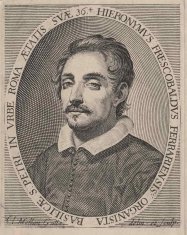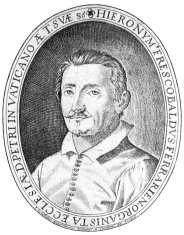|
|
Girolamo Frescobaldi (Composer) |
|
Born: baptised mid-September 1583 - Ferrara, Italy
Died: March 1, 1643 - Rome, Italy |
|
Girolamo (Alessandro) Frescobaldi was an Italian musician, one of the most important composers of keyboard music in the late Renaissance and early Baroque periods, and wrote also church music and secular vocal works. |
|
Biography |
|
Girolamo Frescobaldi was born in Ferrara. His father was a musician and a prominent Ferrarese citizen. There is no evidence that the Frescobaldi of Ferrara were related to the homonymous Florentine noble house. Girolamo studied with the Ferrarese court organist Luzzasco Luzzaschi (a debt he often acknowledged in dedications), from whom he received training on Vicentino's chromatic archicembalo as well. He was named organist at the Accadernia della Morte in 1597 at the age of 14. He is also considered to have been influenced by Carlo Gesualdo, who was in Ferrara at the time.
At some point Girolamo Frescobaldi came under the patronage of Guido Bentivoglio, a cleric and member of a powerful Ferrarese family. The duchy of Ferrara reverted to the papacy upon Alfonso's death in 1597; the principal Vatican figure in the affair, Cardinal Pietro Aldobrandini, promised a post at the papal court to Guido, who soon went to Rome, taking Frescobaldi with him. Girolamo was admitted to the Accademia di S. Cecilia in 1604 and became organist at S. Maria in Trastevere in 1607. He accompanied Guido to Flanders in 1607-1608, where a set of his 5-part madrigals was published. He was summoned back to Rome by Guido's brother Enzo, a Vatican official, and was appointed organist of the Cappella Giulia, St. Peter's, upon his return, a post he held until his death. He worked also as a member of Enzo's household musica, though he was less than diligent in that post. He married in 1612 after fathering two illegitimate children by his future wife; by 1615 he seems to have left the service of the Bentivoglio family for that of Cardinal Aldobrandini, while the court of Mantua made an abortive effort to engage him in that same year.
The next thirteen years were his most fruitful in terms of output, with the two books of toccatas, sets of ricercars, canzonas, and capriecios, and a collection of ensemble canzonas appearing during this time. In addition, his fame as a keyboardist continued to grow; he took various engagements while keeping his posts at the Vatican and with the Aldobrandini family. He was in the employ of the Medici in Florence, from 1628 to 1634. His only works from this period are the two books of Arie musicali, encompassing strophic songs, through-composed madrigals, and works in stile recitativo. Returning again to Rome, he resumed playing at St. Peter's, in addition taking a post with Cardinal Francesco Barberini and appearing at the celebrated Oratorio del Crocifisso during Lent; the French viol player André Maugars commented in 1639 on his masterly improvisations at these Lenten performances. His international reputation brought Froberger to study with him in 1637-1641. He took ill and died in Rome at the age of 59, amidst the chaos of the final years of the Barberini papacy of Urban VII. A grave bearing his name and honouring him as one of the fathers of Italian music exists in the Church of the XXII Apostles in the same city. |
|
Keyboard Works |
|
The majority of Girolamo Frescobaldi's extant output consists of keyboard music. His renowned prowess at the keyboard earned him several important international students, such as Johann Jacob Froberger, who composed pieces highly reminiscent of Frescobaldi's. The Fiori Musicali and the two books of Toccatas and Partitas are his most important keyboard works.
The Fiori musicali (1635) is a collection of organ works designed to be played during the mass service. It also features ricercari, a delicate and sophisticated form of musical counterpoint which includes imitative (or fugal) devices.
His two books of Toccatas and Partitas are written in copper-engraved keyboard tablature for the harpsichord or organ, and were published between 1615 and 1637. Both books open with a set of twelve toccatas written in a flamboyant improvisatory style and alternating fast-note runs or passaggi with more intimate and meditative parts, called affetti, plus short bursts of contrapuntal imitation. In these toccatas, Frescobaldi makes ample use of sharp, unprepared dissonances and other harmonies daring for the time, as well as of virtuosic techniques that make some of these pieces challenging even for modern performers--such as his Toccata IX of Book II, which he himself labelled with the words "Not without toil will you get to the end."
Besides the toccatas, these books feature partitas on popular motives and basses of the time, as well as 6 canzoni, dances, hymns and other compositions such as the Cento Partite Sopra Passachagli, one of his most virtuosic and experimental works. These two books are prefaced by Frescobaldi's own advice on interpretation, where the composer articulates the "theory of musical affections" prevalent at the time. |
|
Other Works |
|
Girolamo Frescobaldi's other extant instrumental output consists chiefly in the 1st Volume of Canzoni to be Played with any Type of Instrument, 1628. This work includes instrumental canzonas for one, two, three and four parts over thorough-bass, as well as a few other pieces such as the Toccata for Spinet and Violin. His vocal music includes a number of masses, motets and madrigals. |
|
Influence |
|
Girolamo Frescobaldi was one of the inventors of the modern conception of tempo, making a compromise between the ancient white mensural notation with a rigid tactus and the modern notion of tempo, which is characterised by acceleration and deceleration within a piece. He is one of the most illustrious organists and composers we know. He is responsible for making a synthesis of all styles preceding his time and for combining subjectivity with logic, and dramatic passion with lyricism. His compositions were central to keyboard study until well into the next century; Gasparini was among those commending them. Revised versions of earlier toccatas and ensemble canzonas show him to be concerned with the final state of his work.
G. Frescobaldi's music was a very important influence on later composers. Through his pupils, Johann Jakob Froberger and Johann Pachelbel, he wielded an indirect influence on J.S. Bach. |
|
J.S. Bach Connection |
|
As we know from a letter which Carl Philipp Emanuel Bach addressed to J.N. Forkel on January 13, 1775, J.S. Bach was acquainted with Frescobaldi's music from his boyhood years in Ohrdruf, and some of his early chorale preludes for organ reflect certain stylistic traits of Frescobaldi's works, above all his toccatas and canzonas. J.S. Bach also possessed a manuscript copy of Frescobaldi's Fiori musicali (Venice, 1635), which he signed and dated 1714 (see BDok i, Anh. I/5); it was later in the collection of the Akademie für Kirchen- und Schulmusik, Berlin, but was destroyed during World War II. Frescobaldi's mastery in this collection is matched in J.S. Bach's Clavier-Übung III, which contains two 'organ masses' (consisting of Kyrie and Gloria) and a supplementary series of chorales and free pieces, recalling the three organ masses and other pieces of Frescobaldi's publication. |
|


|
|
Source: Wikipedia Website (based on Frederick Hammond (1-7, bibliography), Alexandersilbiger (8-15, work-list): 'Frescobaldi, Girolamo Alessandro, §1: Ferrara, Rome and Flanders, 15831608', Grove Music Online, accessed December 4, 2006); HOASM Websiute; Malcom Boyd, editor: Oxford Composer Companion J.S. Bach (Oxford University Press, 1999, Article author: Alberto Basso)
Contributed by Aryeh Oron(November 2008) |
|
Works copied / performed by J.S. Bach |
|
Fiori Musicali (1635) - copied / performed by J.S. Bach in Weimar 1714 |
|
Works in J.S. Bach's Library |
|
Fiori Musicale - w/ Kyrie versets, 4vv. Kybd [J.S. Bach's personal copy, now lost]
Fiori musicali: Toccata
Fiori musicali: Ricercar |
|
Links to other Sites |
|
Girolamo Frescobaldi (Wikipedia)
HOASM: Girolamo Frescobaldi
Frescobaldi, Girolamo: Biography (Sojurn)
Girolamo Frescobaldi (1583 - 1643) (Karadar) |
Frescobaldi Project
Classical Net - Basic Repertoire List: Frescobaldi
Girolamo Alessandro Frescobaldi Biography (Naxos)
Girolamo Frescobaldi, Biography, Discography (Goldberg) |
|
Bibliography |
|
Domenico Morgante: Girolamo Frescobaldi, in Dizionario Enciclopedico Universale della Musica e dei Musicisti (DEUMM), Le Biografie, vol. III (Torino, UTET, 1986)
Frederick Hammond: Girolamo Frescobaldi (Cambridge MA: Harvard University Press, 1983)
N. Koptschewski: 'Stilistischc Parallelen zwischen dem Klavienwerk Frescobaldis und dem Spätwerk Bachs', in W. Hoffmann and A. Schneiderheinzc, eds., Bericht uber die Wissenschaftliche Konferenz zum V. Internationale Bachfest der DDR in Verbindung mit dem 60. Bachfest der Neuen Bachgesellschaft (Leipzig, 1988), pp. 437-47. |
|
|